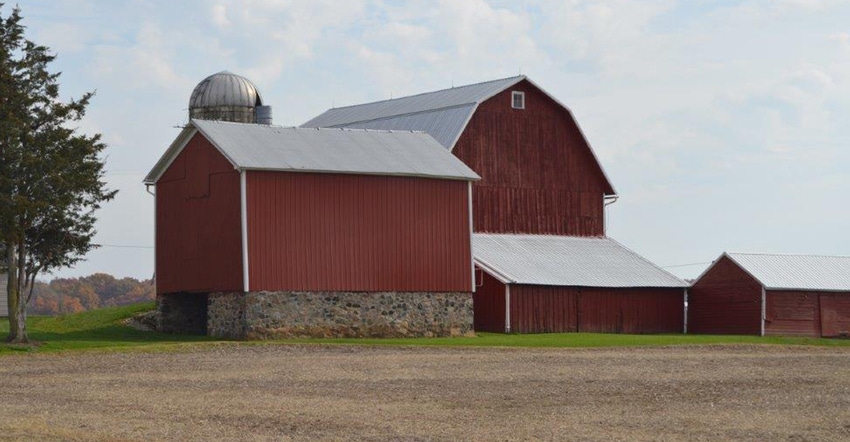August 28, 2017

When Carl F. Nearnberg, a German immigrant, bought his farm near Albion in 1896, it likely never occurred to him to wonder what the place might look like 121 years later. If he was alive today, he would be proud of his heirs.
The Dwight Nearnberg barns are located at 29690 Albion Road in Albion.
Dwight Nearnberg and his sister, Diane, live a stone’s throw from one another in the two homes on the family farm once owned by their great-grandfather. Dwight and his wife, Linda, reside is the original house built by James Lake in 1840. Diane lives in the house her parents built.
The siblings are two of four, with brothers Duane and David, completing the group. Diane set aside her career to be the family caregiver, while Duane operates another farm near Homer, and David is a full-time truck driver.
“We have a picture of my great-grandparents and my grandfather,” says Diane, “and it is dated 1916. I can see one of the barns in the background. So we know it had to have been built before then and think it might go back to between the building of the house in 1840 and 1896. Another picture shows multiple barns as being here in 1941.” The largest of the four barns is roughly 40 by 80 feet, including a lean-to.
Diane says the horse barn was beside the main barn at that time, but the milkhouse had not yet been added. That was shortly before regulations came into being to improve sanitation in the dairy industry, with requirements for separate milk storage facilities, concrete flooring, gutter cleaning and other features.
Super-sleuthing with old family photos is sometimes what has to be done to document history. A picture can reveal a great deal of information, not just for the “who” that is in it, but for the “what” as well. And both pieces of information are valuable, especially when someone has taken the time to also document the “when.”
Carl F. Nearnberg’s farm was passed on to his son, Harry Nearnberg who did the best he could to do the work, though eventually rheumatoid arthritis made that work nearly impossible for him and his wife, Mable.
The farm passed to Carl E. Nearnberg, after Harry’s death, when an ornery cow turned on Harry when he was driving the cattle across the railroad tracks, knocking him down so forcefully he hit his head on a rail, an injury from which he never recovered.
Carl and his wife, Lillian, took over and milked about 25 Holstein, a good-sized herd for the 1940s and early 1950s.
“I was born in 1958, and Dad was still milking,” says Dwight. “But we were going to have to modernize by getting a bulk tank and either expand or sell. So, we sold the herd and went to raising beef cattle.”
Dwight remembers when hay was being put in the mow for the livestock and his father took one too many steps backward at the top of the stack, landing several feet below and suffering broken ribs. He recalls too, the time the family dog climbed on a hay rack, then onto a beam, following its nose. When the dog realized it couldn’t turn around nor back up safely at that height, it lain on the beam and waited for help to arrive.
“She was a big dog and about 8 feet off the floor,” Dwight says, “I had to tell her to jump into my arms and she did!”
Dwight laughs, remembering his own experience with heights. “I had climbed the outside of the silo for the first time, and when I looked up and saw the clouds moving, I thought the silo was swaying,” he says.
Today, Nearnberg Farms raises crops. There are no livestock on the Nearnberg farm, yet all the barns are well-maintained and the grounds are neat and tidy. The main barn is used for storage. The only horse power in the horse barn comes from the lawnmowers kept there. The granary is empty.
“We keep the barns maintained,” Dwight says, “to keep the heritage alive. “I want to preserve the heritage.”
Arnett writes from Battle Creek.
About the Author(s)
You May Also Like




